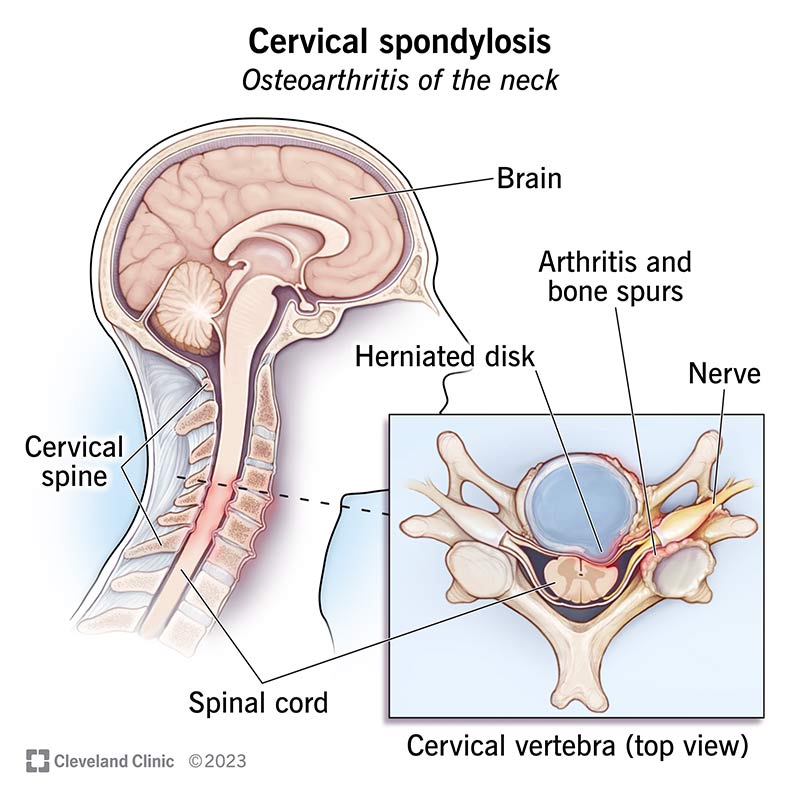“Cervical spondylosis,” sometimes called arthritis of the neck, is a general term for wear and tear that affects your cervical spine. If you have cervical spondylosis, your neck may ache, hurt or feel stiff. Healthcare providers can’t cure cervical spondylosis, but they can keep it from getting worse. Just as important, there are things you can do to protect your neck.
Advertisement
Cleveland Clinic is a non-profit academic medical center. Advertising on our site helps support our mission. We do not endorse non-Cleveland Clinic products or services. Policy

“Cervical spondylosis” is a general term for wear and tear that affects your cervical spine. Cervical refers to seven stacked bones (vertebrae) in your neck. Spondylosis is when parts of your spine begin to wear out. Healthcare providers sometimes call it osteoarthritis of the neck or arthritis of the neck.
Advertisement
Cleveland Clinic is a non-profit academic medical center. Advertising on our site helps support our mission. We do not endorse non-Cleveland Clinic products or services. Policy
If you have cervical spondylosis, your neck may ache, hurt or feel stiff. Healthcare providers can’t cure cervical spondylosis, but they can keep it from getting worse.
It’s very common and a natural consequence of growing older. As we age, our spines start to change and wear out. This usually happens when people are in their 30s. By age 60, about 9 in 10 people have cervical spondylosis.
You can have cervical spondylosis without symptoms. If you do have symptoms, they may include:
The most common cause is changes in your spine that happen as you age. Changes may include medical conditions, including:
Cervical spondylosis happens over time. Triggers or risk factors include:
Cervical spondylosis increases your risk of developing:
Advertisement
No, it can’t. Cervical spondylosis just affects the disks in your spine, which can make your neck hurt or feel stiff.
A healthcare provider will do a physical examination, including looking for bumps or knots in your neck. They may check your:
Your provider may do the following tests to get detailed images or pictures of your spine and check on your skeletal muscles and nerves. Tests may include:
The best treatment is one that helps ease your symptoms. In general, healthcare providers start cervical spondylosis treatment with noninvasive, conservative treatments. For example, they may recommend:
If you have significant neck pain, your provider may recommend treatments like cervical epidural steroid injection or radiofrequency ablation.
If these treatments don’t help or your condition is a complication of cervical myelopathy or cervical radiculopathy, your provider may recommend spinal fusion surgery.
Conservative treatments rarely cause side effects. Treatments like spinal fusion surgery, steroid injections or radiofrequency ablation have different side effects. Your healthcare provider will explain what you can expect, including any treatment side effects and complications.
This is a chronic condition, which means there’s no cure. But there are ways to treat cervical spondylosis so its symptoms don’t affect your quality of life.
Most of the time, cervical spondylosis is a side effect of growing older. You can take care of your neck by:
Contact a healthcare provider if you have neck pain or stiffness that doesn’t go away after a few days. You should also contact your provider if you’re receiving treatment for cervical spondylosis and your symptoms don’t go away or get worse.
Advertisement
Sometimes, severe neck pain along with the following symptoms may be signs of a serious medical issue. Seek medical attention right away if you have:
You may want to ask the following questions:
Our bodies change as we age, and one of those changes may be cervical spondylosis. It can make your neck hurt, ache or feel stiff. Everyone’s susceptible, but people who spend hours looking up toward the ceiling or down toward the ground are more likely to develop it. Healthcare providers can’t cure cervical spondylosis, but they have treatments to make your neck less stiff or painful. Talk to a healthcare provider if your neck hurts or feels stiff for more than a few days.
Advertisement
Everyday things like turning your head shouldn’t be a pain in the neck. Cleveland Clinic medical spine experts can find ways to ease your cervical neck pain.

Last reviewed on 09/30/2023.
Learn more about the Health Library and our editorial process.